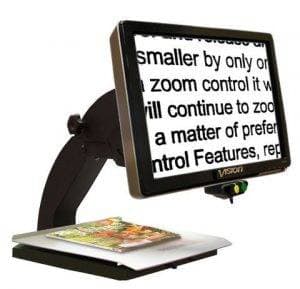Retinal detachment can lead to permanent vision loss, if not treated immediately.
Retinal detachment threatens irreversible vision loss and is a common cause of low vision.
Fortunately, low vision aids have been designed to maximize on remaining vision, to increase independent functioning and improve quality of life.
What is retinal detachment?
Every year, an estimated 1 in 1,000 Americans are diagnosed with retinal detachment.
The retina is the light-sensitive tissue that is securely fixed to the back of the eye and nourished by a network of blood vessels beneath it, called the choroid.
When the retina is pulled away from its normal position— which can occur from a number of underlying conditions— it can result in retinal detachment.
This becomes an eye emergency, as the retina can no longer receive its essential nourishment from the choroid, and the photoreceptors in the retina cannot survive without a constant blood supply.
When the retinal cells begin to die, the result is vision loss.
SEE RELATED: What is Low Vision?
If you notice any changes in your vision or any of the symptoms listed above, contact an eye doctor immediately to prevent permanent vision loss.
What are the symptoms of a retinal detachment?
A retinal detachment can be gradual or occur suddenly, depending on the severity and location of the detachment.
Symptoms of retinal detachment can occur in one or both eyes.
The earliest noticeable signs include:
- Sudden increase in seeing light flashes and floaters
- Appearance of a dark shadow or “curtain” in your vision
- Blurred and distorted vision
- Straight lines appear wavy
In some cases, if the retinal detachment is small, symptoms may not be noticeable at all.
How do low vision aids help?
Although prompt treatment can help to prevent total vision loss from retinal detachment, there is still a chance that some degree of permanent vision loss will occur— especially if the macula, the center of the retina, is affected.
Low vision is defined as an optical prescription of 20/200 or worse, that cannot be corrected with glasses, contact lenses or surgery.
Fortunately, low vision aids and devices have been designed to help patients with low vision to regain their independence for daily activities, such as watching TV, working on a computer or participating in social events.
A wide range of low vision aids and devices have been created for patients with varying degrees of vision loss. These aids are available in both low-tech and high-tech designs to facilitate accessibility for patients of all ages.
Some of the most popular low vision devices include:
- Telescopic and microscopic glasses
- Mounted or stand magnifiers
- Handheld magnifiers and
- Computerized devices
- Video magnification systems
LEARN MORE: Guide to Low Vision
If you notice any changes in your vision or have been diagnosed with low vision, contact an eye doctor near you.
Retinal detachment threatens irreversible vision loss and is a common cause of low vision.
Fortunately, low vision aids have been designed to maximize the remaining vision, to increase independent functioning and improve quality of life.










